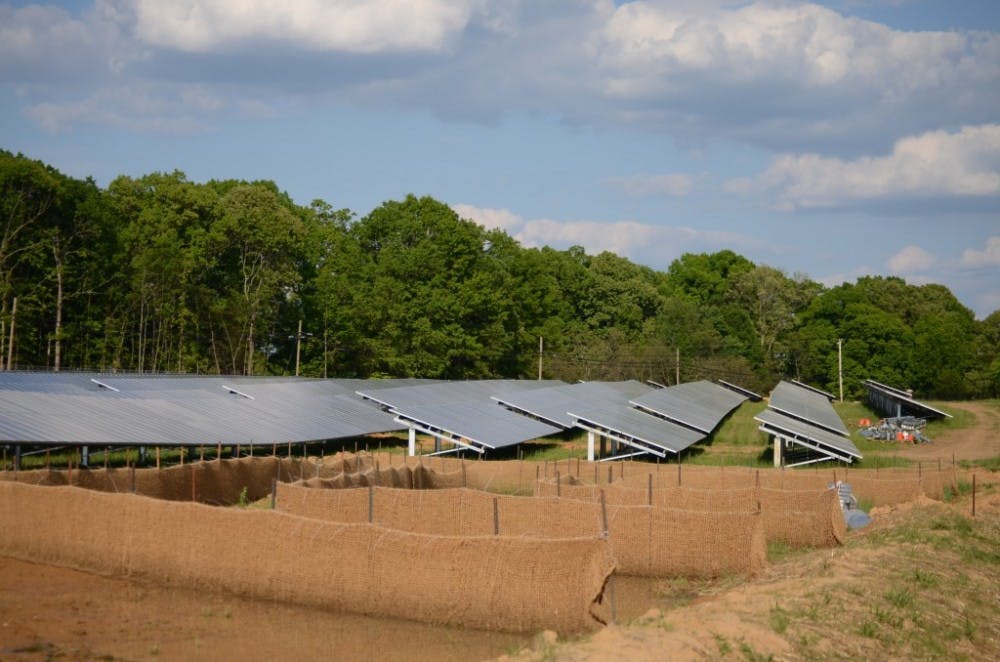By the end of May, the 9,900 photovoltaic panels that now occupy 10 acres of Loy Farm will officially be generating power into a grid that connects to the railroad tracks by Williamson Avenue.
The project, which broke ground in early March, is estimated to produce 4,500 megawatts of electricity annually–enough to power 415 homes–according to Robert Buchholz, Elon University’s associate vice president for facilities management and director of Physical Plant.
“There’s two ways we look at it,” Buchholz said. “There is a percentage of what Elon uses for the whole year, and that’s 10 percent. During the day, that’s 40 percent of the energy that we use. Students use a lot.”
Buchholz said the amount of energy produced depends on sun and clouds–power will be generated during the 12-hour window of sunlight.
The panels cost about $3 million and will have about a 20-year payback. This compares to the $5 million Buchholz was told it would cost about seven years ago.
The project was developed by Suntuity and funded by Loy Farm Solar LLC, who are leasing the property from the university for the next 20 years. As an incentive to pay for expensive projects like the solar panels, they are given 65 percent subsidies by the state and federal government. In other words, for every dollar paid, 65 cents are given in tax credits.
Elon is not directly benefiting from electricity produced by the panels yet but receives money for renting out the farm and hopes to obtain the solar farm in the near future.
“It takes about seven years to get the best benefits out of the project,” Buchholz said. “It means that the investors who put up the money would all have their tax benefits out of it and hopefully we can buy the farm.”
Students will have the opportunity to study the equipment and economic model of the operation as well as the legal side.
“I’ve been with this project from the very beginning,” Buchholz said. “The purpose was to be used in the academic side so questions and answers could be made from the business, law and environmental studies programs.”
Students think the potential of the project will outweigh any drawbacks in time and costs.
“Overall it will be good down the line,” said sophomore Samantha McCabe, an Eco-Rep. “But it’s still in an early stage and will take a few years before they power buildings and such.”
Not all are convinced the panels will be as beneficial as they are made out to be.
Professor of Health and Human Performance Michael Calhoun proposed the use of solar panels at a long range planning committee more than 20 years ago. But he doesn’t believe they are as cost-effective or environmentally friendly as he originally thought technology would be by now.
“In order to construct a solar farm it is not cost effective unless you get subsides, in this case taxpayers dollars,” Calhoun said. “I personally don’t want to spend my tax dollars on something that’s not cost-effective.”
In addition to being costly, Calhoun points out the energy and fossil fuels it took to make the steel structure, copper wiring and panels as well as the transportation and labor involved.
Calhoun said it’s doubtful the photovoltaic panels will ever return to the grid what it took to make and pay for it.
He does agree the panels fit with Elon’s mission to be a sustainable model.
“It’s nice,” Calhoun said. “It makes a great statement. It looks very sustainable, but I’m resonable sure it won’t do what it’s intended to do.”
Calhoun suggests for Elon to be green, cost effective and efficient, a graduate nuclear physicist program should be started and a nuclear energy producing, micro-reactor should be installed.
Calhoun believes the university could sell the energy back to grid and pay for the costs of the reactor and program. He also said it’s impossible to make nuclear weapons from it and the university has room to hold it.
“Let’s be the university that has the courage to be cutting edge,” Calhoun said. “We could be a model for the rest of the world.”
Although it is not known how much energy and fossil fuels were used to produce the solar panels, Buchholz still believes Suntuity chose the most cost-effective panels. He also sees this as an opportunity for students to investigate the efficiency and costs of solar panels as their own research.


